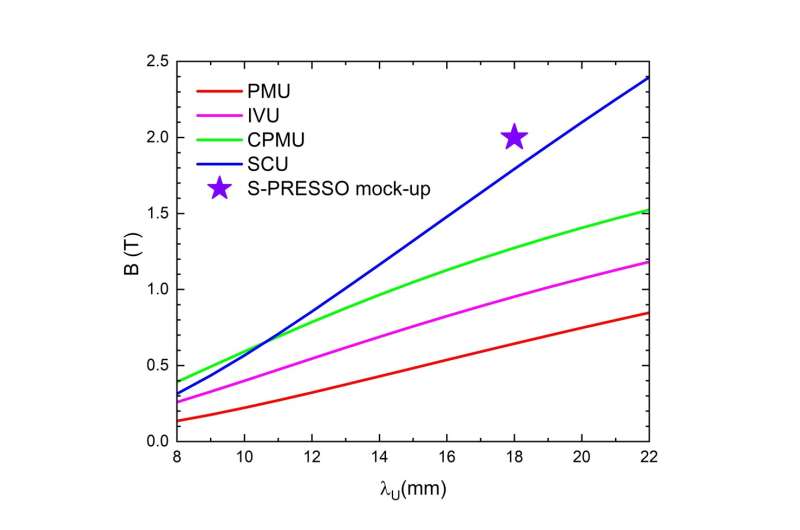This article has been reviewed according to Science X's editorial process and policies. Editors have highlighted the following attributes while ensuring the content's credibility:
fact-checked
proofread
Milestone reached for superconducting undulator for European XFEL

A European XFEL team at the Karlsruhe Institute for Technology has tested a mock-up coil of the superconducting undulator pre-series module (S-PRESSO) designed for an upgrade of the European XFEL. It achieved a record-breaking magnetic field. This milestone is reported in Frontiers in Physics.
Undulators are one of the most important devices for a free-electron laser like the European XFEL in Schenefeld near Hamburg. With the help of a series of strong magnets an undulator creates an extremely brilliant light by forcing fast-moving electrons onto a slalom course. Furthermore, the undulators stimulate the electrons to emit laser-like electromagnetic radiation.
The strength of the magnets of an undulator determines the tunability of the photon energy range available for experiments. The Undulator Systems Group of European XFEL has started different activities in collaboration with Deutsches Elektronen-Synchrotron DESY to allow the implementation of superconducting undulators into the European XFEL in the upcoming years.
The contract for superconducting undulator pre-series module (S-PRESSO) consisting of two pairs of coils and a phase shifter has been assigned to Bilfinger Noell GmbH. Now, a European XFEL team at the Karlsruhe Institute for Technology has tested a 30-centimeter-long mock-up superconducting coil designed and build by Bilfinger Noell GmbH. The magnetic field of the S-PRESSO mock-up has reached 2 Tesla, which is the largest ever reached in such undulators.
European XFEL is planning to use superconducting undulators to reach lasing at unprecedented short wavelengths and high photon energies above 50,000 electronvolt (50 keV). Such very hard X-rays are necessary for studying non-reproducible processes that live on time-scales of microseconds to femtoseconds and happen in difficult-to-access sample environments.
X-ray lasers are an outstanding tool for the research on biomolecules, drugs, solid materials or even quantum states. Moreover, they are important for high energy density science to study planet evolution and for in-situ microscopy on technological processes, for example welding or battery research.
More information: Sara Casalbuoni et al, Superconducting undulator activities at the European X-ray Free-Electron Laser Facility, Frontiers in Physics (2023). DOI: 10.3389/fphy.2023.1204073
Provided by European XFEL GmbH





















